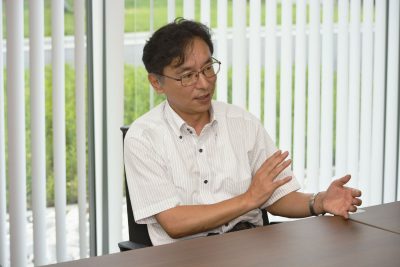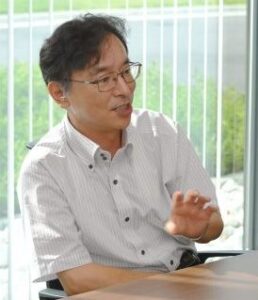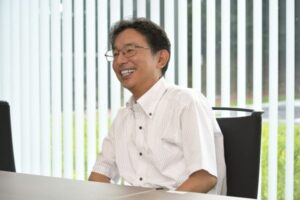Director Senior Executive Officer
Takashi Saito
Director Takashi Saito took on his role as a director in June 2017. Gigaphoton was established in 2000 as a joint venture (dissolved 2011) with Ushio Inc., and Director Saito transferred from Ushio to Gigaphoton following his secondment. I talked to Mr. Saito who, following his roles as Deputy General Manager of the Development Division and General Manager of the Customer Support Division (CS), now serves as General Manager of the EUV Development Division, and also Managerial Director of Laser Development and Quality Assurance, thus acting as a keystone in technological development for the company.
―It’s been a year and a half since your appointment as director, so what sort of things would you consider to be current issues for the company?

The issues within the company became clearer to me through my participation in the management team. Amongst short-term issues would be strengthening competitiveness in excimer lasers for lithography (DUV). Particular points would be the increase in lifespan for parts, as well as energy and wavelength stability. I also feel that the training of field service engineers (FSE) and global personnel who are capable of effective communication with our various local corporations would be a pressing task. More long-term issues would include the expansion of our next businesses and the development of EUV*. I think that as our present DUV business is running smoothly, the current time offers us an opportunity. Meanwhile, we will develop our laser business targeting annealing for flat panel displays (FPD), while concurrently making challenges in other fields. Also, there’s not only our light source business, we’ve begun sowing our seeds in the field of analysis software, such as with FABSCAPE, so we hope that this will soon become one of the pillars of our business. The extent to which we persevere with EUV will be the key. I want to demonstrate Gigaphoton’s strengths and make this work as a business as soon as possible.
―As General Manager of the EUV Development Division, please tell us your thoughts with regard to EUV.

In the lithography world, the next generation light source will surely be EUV, so without EUV, it will no longer be possible to say that we are doing a cutting-edge business as a light source manufacturer. I’m not sure how many years it will take, but at some point, when DUV becomes commoditized and EUV becomes available worldwide, isn’t it likely that there will be a drop in motivation for any company working in the lithography industry without this? In order to avoid this situation, I’d also like to make the case for our company’s strength in the technology of debris mitigation, and to enter the business as soon as possible.
―It’s been more than 15 years since EUV development started, hasn’t it?
Yes, that’s right. However, it’s also taken about thirty years for DUV to become as profitable as it is now. EUV research began at Komatsu around 2003, but in-house research and development began after dissolving the joint venture with Ushio in 2011. Its history is long, but from the point of view of our starting development in earnest, it’s actually still quite recent. The cost of EUV compared to DUV also differs by an order of magnitude, and it is big business on our company’s scale, but for the limited research budget, I have the impression that these select few have done well to push their way this far.
―What do you consider to be the strengths of Gigaphoton?
I think it’s a good thing that, for a company founded just under 20 years ago, we still have members who have been here since our inception. Another point is that we continue with the pattern firmly established through those past successes left as company assets by these individuals. Also, as the company grew rapidly, many people from other companies have come to work with us, with some of them now active as central figures in Gigaphoton. Successfully bringing in new blood from elsewhere as the company grows in this way can also be said to be a strength of the company. I wonder if this might not be a characteristic of the free corporate style, in which there aren’t really boundaries between the top level and persons in charge. Also, I think that it is a very good thing that prominent people, considered legendary in the lithography industry, are enrolled in our company in advisory positions. There are so many things to learn from such people, so I’d particularly hope that people in research and development will absorb anything they can from them.
―Amongst your experiences so far, what kind of things have left an impression on you?
First of all, when I was a product manager for development in 2001, I developed a single chamber system ArF excimer laser for what is now the largest OEM in the industry. Unfortunately it didn’t sell very well, but I believe that the relationships we built at this time led to the sales of the subsequent twin chamber system laser, and they were also the foundation of our present good relationship with our customers. Also, I served as Deputy General Manager and General Manager of the Customer Support Division for five years from 2007. Until then I’d been exclusively concerned with development, so at the outset there were all sorts of things that I didn’t understand at all. This would be unthinkable now, but when I’d just transferred to the CS Division, we’d have stocktaking for parts, and at that time, we’d find considerable discrepancies due to inadequacies in our procedures. Nevertheless, I accepted reports saying “That’s just the nature of stocktaking isn’t it?” After realizing this was not correct, things were soon returned to a normal condition, but just after my transfer, I had no feel for inventory management at all, and didn’t pick up on the abnormality straightaway. Thanks to my experience in the CS Division, I was able to learn the workings of the company, such as in sales, services, inventory management and export control, which I think was really positive.
―Finally, may I ask you about any dreams you might have?

Well, firstly, from the point of view of my work, I’d like Gigaphoton to become the kind of company for which future sales could reach 100 billion yen. I think EUV is the key to that of course. If our business could work as well with EUV as it currently does with DUV then I think this should be possible. With regard to my personal life, I go camping with my family and friends every year, and have done so for about 20 years now, but recently my children have grown up and they’re helping me with most of the various preparations. So, it’s got to the point where I’m thinking I’d like to take a campervan trip just with my wife, as a couple. It would also be nice to make some trips traveling on those luxury trains that they have in various places. Either way, this is still all in the future for me, but I’d like actually to try these things when I have a little more time to play with.
*EUV – Stands for Extreme Ultraviolet which is a lithography technology that uses light sources that emit extremely short wavelength (13.5 nm) light to achieve finer-scale processing.